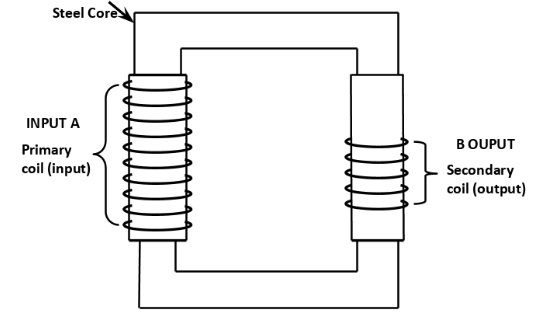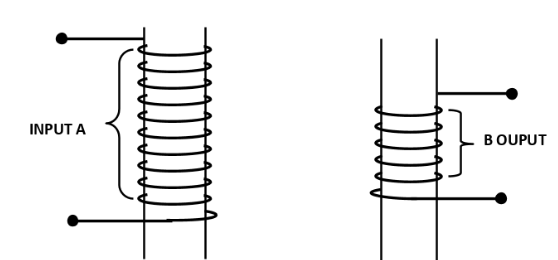
Answer
439.5k+ views
Hint: The transformer works on the principle of electromagnetic induction. The windings constitute the electrical properties and the core to which the windings are wound has magnetic properties. The transformers are divided into step-up and step-down based on the number of turns of the primary and secondary windings.
Complete answer:
The transformer is used to transfer the alternating electric power from one circuit to another circuit at the same frequency. It is known as a static device as it does not have any moving part.

A transformer has three main parts. They are two windings and a metallic core on which the windings are wound. The windings are made up of a coil that is a good conductor of current. These winding coils behave as an inductor. When an alternating current is allowed to flow through any of the winding, an alternating flux is produced. In the diagram, Part A is connected to the input. Therefore, that will be the primary winding. And, Part B is connected to the output. Therefore, that will be the secondary winding. So, the parts labelled A and B are the primary and the secondary windings respectively.
To transfer the alternating electric power from one winding to another, a magnetic core is placed between these two windings. Therefore, the incomplete part was the magnetic core. Steel and iron are the magnetic materials used for magnetic cores. If the transformer has more secondary winding turns than primary winding turns, then it is called a step up transformer. And, if the transformer has more primary winding turns than secondary winding turns, then it is called a step down transformer. In the given diagram, the number of primary windings are more than secondary windings. Therefore, it is a step down transformer.
Note: The step up and step down transformers can also be classified on the basis of voltages of windings. If the transformer has more secondary winding turns than primary winding turns, then the voltage increases from primary windings to secondary windings. The voltage increases and therefore it is known as the step up transformer. Conversely, the voltage decreases from primary windings to secondary windings in a step down transformer.
Complete answer:
The transformer is used to transfer the alternating electric power from one circuit to another circuit at the same frequency. It is known as a static device as it does not have any moving part.

A transformer has three main parts. They are two windings and a metallic core on which the windings are wound. The windings are made up of a coil that is a good conductor of current. These winding coils behave as an inductor. When an alternating current is allowed to flow through any of the winding, an alternating flux is produced. In the diagram, Part A is connected to the input. Therefore, that will be the primary winding. And, Part B is connected to the output. Therefore, that will be the secondary winding. So, the parts labelled A and B are the primary and the secondary windings respectively.
To transfer the alternating electric power from one winding to another, a magnetic core is placed between these two windings. Therefore, the incomplete part was the magnetic core. Steel and iron are the magnetic materials used for magnetic cores. If the transformer has more secondary winding turns than primary winding turns, then it is called a step up transformer. And, if the transformer has more primary winding turns than secondary winding turns, then it is called a step down transformer. In the given diagram, the number of primary windings are more than secondary windings. Therefore, it is a step down transformer.
Note: The step up and step down transformers can also be classified on the basis of voltages of windings. If the transformer has more secondary winding turns than primary winding turns, then the voltage increases from primary windings to secondary windings. The voltage increases and therefore it is known as the step up transformer. Conversely, the voltage decreases from primary windings to secondary windings in a step down transformer.
Recently Updated Pages
The radius of curvature of a plane mirror is a positive class 10 physics CBSE

Choose the word which is closest to the opposite in class 10 english CBSE

Select the antonym for the following word from the class 10 english CBSE

Select the synonym for the given word Transparency class 10 english CBSE

Select the given word which means the opposite of the class 10 english CBSE

The purest form of carbon is a Graphite b Diamond c class 10 chemistry CBSE

Trending doubts
How do you graph the function fx 4x class 9 maths CBSE

Which are the Top 10 Largest Countries of the World?

Fill the blanks with the suitable prepositions 1 The class 9 english CBSE

What is the meaning of sol in chemistry class 11 chemistry CBSE

The Equation xxx + 2 is Satisfied when x is Equal to Class 10 Maths

The capital of British India was transferred from Calcutta class 10 social science CBSE

Why is there a time difference of about 5 hours between class 10 social science CBSE

Capital of the Cheras was A Madurai B Muziri C Uraiyur class 10 social science CBSE

What organs are located on the left side of your body class 11 biology CBSE





